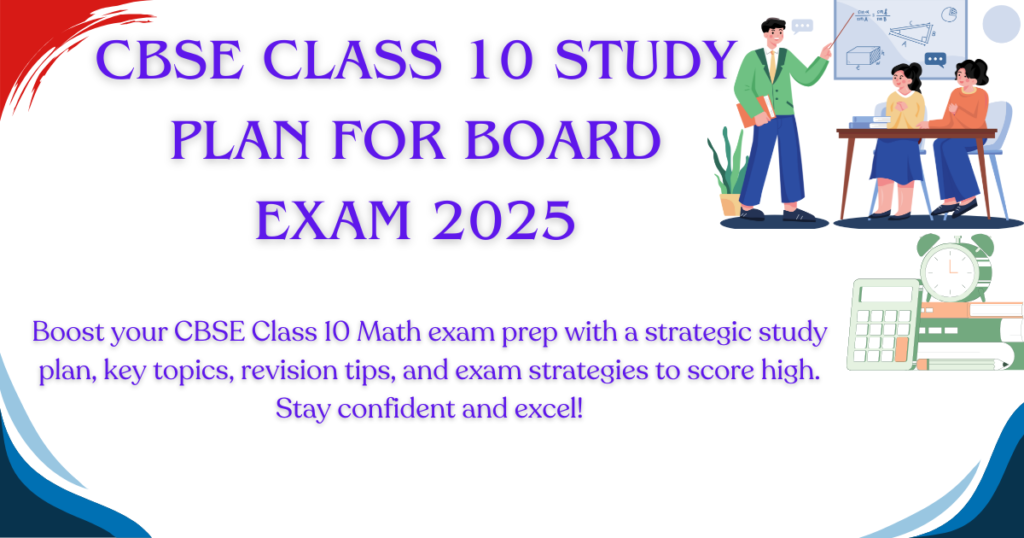A Comprehensive Guide to Ace Your CBSE 2025 Math Exam

The CBSE Class 10 Math board exam is one of the most crucial tests for students, and with the exam scheduled for March 10, 2025, there is ample time to refine your preparation strategy. A well-structured study plan focusing on conceptual clarity, regular practice, and smart revision techniques can significantly enhance your performance. In this guide, we provide a detailed study plan, key topics, revision techniques, and strategies to avoid common mistakes, ensuring you make the most of the 10-day gap after the Hindi exam.
Table of Contents
CBSE Class 10 Math Exam Pattern 2025
Before diving into the study plan, it’s essential to understand the exam structure:
- Section A: 20 Multiple Choice Questions (1 mark each)
- Section B: 5 Questions (2 marks each)
- Section C: 6 Questions (3 marks each)
- Section D: 4 Questions (5 marks each)
- Section E: 3 Case Study Questions (4 marks each)
- Total Marks: 80
Strategic Preparation Plan
Early Preparation (Before February)
- Understand the Syllabus: Identify high-weightage chapters and allocate time accordingly.
- Concept Clarity: Focus on understanding rather than memorization to tackle application-based questions.
- Regular Practice: Solve NCERT problems, sample papers, and previous years’ questions.
- Time Management: Dedicate fixed time slots for each subject to maintain consistency.
- Mock Tests: Attempt full-length tests under timed conditions for exam readiness.
- Short Notes: Prepare concise notes of formulas and common mistakes for quick revision.
Timeline for February and March
Early February
- Prioritize high-weightage chapters.
- Revise diagrams, formulas, and equations daily.
- Attempt one full mock test each day to gauge progress.
10-Day Study Plan for Math
March 1-2: Algebra (Real Numbers, Polynomials, Quadratic Equations, Linear Equations)
- Revise Real Numbers, focusing on proving irrationality and HCF & LCM problems.
- Study Polynomials, covering the relationship between zeros and coefficients, and graphical representation.
- In Quadratic Equations, practice forming equations from word problems, using the quadratic formula, and checking conditions for real and imaginary roots.
- Revise Linear Equations by understanding the conditions for unique, infinite, and no solutions.
- Solve previous year papers and sample MCQs from these chapters.
March 3-4: Trigonometry & Arithmetic Progression
- Memorize all trigonometric identities and practice application-based problems.
- Solve height and distance questions using step-by-step visualization.
- In Arithmetic Progression, revise the nth term formula and sum formula.
- Work on case study questions related to Trigonometry and Arithmetic Progression.
March 5-6: Geometry (Circles & Triangles) & Mensuration
- Understand the tangent theorem and solve related problems.
- Revise BPT theorem, similarity of triangles, and their applications.
- Study Mensuration formulas and practice surface area & volume problems with figures.
- Work on 4-mark questions from Mensuration.
March 7-8: Statistics & Probability + Full-Length Mock Test
- Revise formulas for Mean, Median, and Mode using direct, assumed mean, and step-deviation methods.
- Practice probability-based MCQs and 3-mark questions.
- Attempt one full-length mock test under timed conditions.
- Identify weak areas and revise them.
March 9: Final Formula Revision & Relaxation
- Go through your Formula and Mistakes Short Note.
- Avoid new topics and focus on revising difficult questions.
- Stay relaxed, sleep early, and ensure mental clarity for exam day.
Exam Day Strategy
How to Utilize the First 15 Minutes of Reading Time
- Scan the question paper quickly to get an overview.
- Identify and segregate questions into three categories:
- Direct formula-based
- Easily doable
- Tricky questions
- Decide in advance which optional question you will solve to avoid confusion.
- Prioritize straightforward questions first and tackle tricky ones towards the end.
Common Mistakes to Avoid
1. Rushing Calculations
One of the most common errors students make is rushing through calculations, leading to mistakes in answers. Always work systematically and double-check numerical values.
2. Ignoring Diagrams
In 5-mark questions, failing to draw diagrams where required can cost valuable marks. Ensure you include clear and labeled diagrams in geometry problems.
3. Not Highlighting the Final Answer
Examiners should be able to easily locate your final answer. Underline or box the final solution to improve presentation.
4. Missing Formulas or Theorems
Not mentioning the formula or theorem used to solve a problem can lead to partial marks being awarded, even if the final answer is correct. Write the formula first before substituting values.
Final Exam Day Tips
- Stay Hydrated: Drink plenty of water and take small breaks to stay refreshed.
- Avoid Electronic Distractions: Stay away from social media and unnecessary phone usage.
- Stay Confident: Trust your preparation and approach the exam with a calm mind.
Final Words of Motivation
“Success is the sum of small efforts, repeated day in and day out.” – Robert Collier
Believe in your hard work, follow the plan, and enter the exam with confidence. With the right strategy and determination, you can score exceptionally well in the CBSE Class 10 Math exam. Good luck!
This structured study plan for exams class 10 is designed to help students optimize their preparation and excel in the CBSE 2025 Math exam. Follow this guide diligently, and you will undoubtedly maximize your score!
CBSE Class 10 Admit Card 2025 Release Date
CBSE Board Exams 2025 Admit Card Out: How to Download at cbse.gov.in
